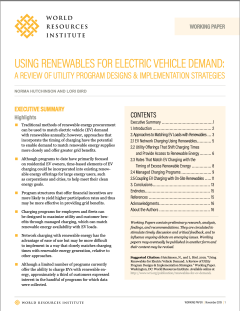
The use of EVs in the United States is growing rapidly, with adoption expected to reach nearly 20 million EVs on the road in the coming decade. EVs are, on average, two to three times more energy efficient than traditional internal-combustion engine vehicles. Although the improved efficiency alone contributes to significant reductions in greenhouse gas (GHG) emissions, the energy sources on the grid, or the grid mix, used for charging determines the overall emissions. As electricity generation continues to transition toward carbon-free sources, electric transportation can provide even greater contributions toward decarbonisation goals.
Large energy users, particularly those with renewable energy procurement goals, are increasingly interested in using clean energy sources to meet new EV demand and are establishing goals to push these efforts forward. Goals are typically designed to cover new EV loads associated with fleet vehicles and in some cases EV loads associated with employee workplace charging or public charging, such as at retail stores.
Aligning EV charging with the availability of renewable energy generation can also provide benefits for the grid, particularly in areas that currently have or anticipate having large amounts of solar or wind generation on the grid. Programs that encourage customers to charge midday, such as through workplace charging, can align well with peak solar output; nighttime EV charging can align well with the availability of wind generation.
